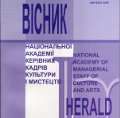БАЛЕТ «МАЛЕНЬКИЙ ПРИНЦ» У ПОСТАНОВЦІ РАДУ ПОКЛІТАРУ: ОСОБЛИВОСТІ ВТІЛЕННЯ КЛАСИКИ
"The Little Prince" Ballet Performed by Radu Poklitaru: Features of Implementation of Classics
Author(s): Olena Stalyevna AfoninaSubject(s): Theatre, Dance, Performing Arts, Cultural history, Music, 18th Century, Sociology of Art, History of Art, Sociology of Literature
Published by: Національна академія керівних кадрів культури і мистецтв
Keywords: embodiment of the classics; literary source; piano music; symphony; fantasy; artistic image; Radu Poklitaru’s "The Little Prince" ballet; Wolfgang Amadeus Mozart; Ukrainian lullabies;
Summary/Abstract: The purpose of the article is to reveal artistic images in "The Little Prince" ballet performance by Radu Poklitar with music by V. A. Mozart and Ukrainian lullabies performed by Maria Pylypchak. The methodology of the work is based on cultural analysis with elements of musicological analysis. The performed analysis provides familiarity with the ballet performance, the production of which took place on the theatre stage. Based on the synthesis of the obtained research results, the regularities of stage development in the interaction of choreography, music, and visualisation were established. The method of generalisation helped to record the sequence of formation of ballet images, disclosure of events in dialogue with music and visual series. The scientific novelty of the work lies in the fact that the analysis of the said ballet by Radu Poklitaru has been conducted. The interaction of choreography, music, and visual series in the embodiment of the philosophical fairy tale by Antoine Saint-Exupéry is revealed. The text of the article can be used when preparing a lecture on teaching music-theoretical and music-historical disciplines. Conclusions. Based on the analysis of "The Little Prince" ballet performance, the musical characteristics of the Little Prince, Rose, Snake and other actors were revealed by Radu Poklitaru. The stage unity of choreography, music, and visual series helped embody artistic images in the music-theatre genre. Choreography (elements of classics, free movements, imagery in movements) is supported by musical emotion and visualisation. The visual series significantly influenced the transmission of the philosophy and content of the literary source. The dramaturgy of the ballet is subordinated to the plot development. The musical basis of ballet became the basis for the realisation of artistic images in ballet: Mozart's works (Symphony No. 1, Fantasia in D minor, Piano Concerto with Orchestra No. 23, Part 2) and Ukrainian lullabies.
Journal: Вісник Національної академії керівних кадрів культури і мистецтв
- Issue Year: 2023
- Issue No: 1
- Page Range: 209-215
- Page Count: 7
- Language: Ukrainian

